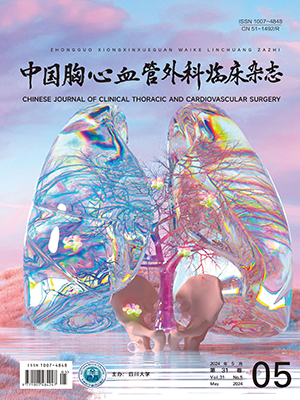| 1. |
Mirhosseini SJ, Forouzannia SK, Ali-Hassan-Sayegh S, et al. On pump versus off pump coronary artery bypass surgery in patients over seventy years old with triple vessels disease and severe left ventricle dysfunction: focus on early clinical outcomes. Acta Med Iran, 2013, 51(5): 320-323.
|
| 2. |
吴清玉, 许建屏, 高长青, 等. 冠状动脉旁路移植术技术指南. 中华外科杂志, 2006, 44(22): 1517-1524.
|
| 3. |
Sun X, Boyce SW, Hill PC, et al. Association of body mass index with new-onset atrial fibrillation after coronary artery bypass grafting operations. Ann Thorac Surg, 2011, 91(6): 1852-1858.
|
| 4. |
韦亚林, 陈福芳, 陈文胜, 等. 非体外循环冠状动脉旁路移植术后新发心房颤动预后因素分析. 中国微创外科杂志, 2019, 19(10): 865-869.
|
| 5. |
Lloyd-Jones DM, Wang TJ, Leip EP, et al. Lifetime risk for development of atrial fibrillation: The Framingham Heart Study. Circulation, 2004, 110(9): 1042-1046.
|
| 6. |
Levy D, Kannel WB. Postoperative atrial fibrillation and mortality: do the risks merit changes in clinical practice? J Am Coll Cardiol, 2004, 43(5): 749-751.
|
| 7. |
Cameli M, Lisi M, Focardi M, et al. Left atrial deformation analysis by speckle tracking echocardiography for prediction of cardiovascular outcomes. Am J Cardiol, 2012, 110(2): 264-269.
|
| 8. |
Haffajee JA, Lee Y, Alsheikh-Ali AA, et al. Pre-operative left atrial mechanical function predicts risk of atrial fibrillation following cardiac surgery. JACC Cardiovasc Imaging, 2011, 4(8): 833-840.
|
| 9. |
Bohatch Júnior MS, Matkovski PD, Di Giovanni FJ, et al. Incidence of postoperative atrial fibrillation in patients undergoing on-pump and off-pump coronary artery bypass grafting. Rev Bras Cir Cardiovasc, 2015, 30(3): 316-324.
|
| 10. |
Shu XU, Zhang J, XU Y, et al. Relationship between angiotensin converting enzyme, apelin, and new-onset atrial fibrillation after off-pump coronary artery bypass grafting. BioMed Research International, 2017, 2017: 1-8.
|
| 11. |
Wu N, Xu B, Xiang Y, et al. Association of inflammatory factors with occurrence and recurrence of atrial fibrillation: A meta-analysis. Int J Cardiol, 2013, 169(1): 62-72.
|
| 12. |
Chauhan VS, Woodend KA, Tang AS. Lower incidence of atrial fibrillation after minimally invasive direct coronary artery bypass surgery than bypass surgery. Circulation, 1997, 96(19): 263.
|
| 13. |
Zaman AG, Archbold RA, Helft G, et al. Atrial fibrillation after coronary artery bypass surgery: A model for preoperative risk stratification. Circulation, 2000, 101(12): 1403-1408.
|
| 14. |
郑哲, 孙殿珉, 高华炜, 等. 影响老龄冠状动脉旁路移植术后新发心房颤动的危险因素. 中国循环杂志, 2011, 26(4): 294-297.
|
| 15. |
Melduni RM, Suri RM, Seward JB, et al. Diastolic dysfunction in patients undergoing cardiac surgery: A pathophysiological mechanism underlying the initiation of new-onset post-operative atrial fibrillation. J Am Coll Cardiol, 2011, 58(9): 953-961.
|
| 16. |
Bramer S, van Straten AH, Soliman Hamad MA, et al. The impact of new-onset postoperative atrial fibrillation on mortality after coronary artery bypass grafting. Ann Thorac Surg, 2010, 90(2): 443-449.
|
| 17. |
Mathew JP, Fontes ML, Tudor IC, et al. A multicenter risk index for atrial fibrillation after cardiac surgery. JAMA, 2004, 291(14): 1720-1729.
|
| 18. |
Aranki SF, Shaw DP, Adams DH, et al. Predictors of atrial fibrillation after coronary artery surgery. Current trends and impact on hospital resources. Circulation, 1996, 94(3): 390-397.
|
| 19. |
Filardo G, Damiano RJ, Ailawadi G, et al. Epidemiology of new-onset atrial fibrillation following coronary artery bypass graft surgery. Heart, 2018, 104(12): 985-992.
|
| 20. |
Choi YS, Shim JK, Hong SW, et al. Risk factors of atrial fibrillation following off-pump coronary artery bypass graft surgery: predictive value of c-reactive protein and transfusion requirement. Eur J Cardiothorac Surg, 2009, 36(5): 838-843.
|
| 21. |
Charles G, Charline PJ, Frederique DB, et al. Incidence and predictors of new-onset silent atrial fibrillation after coronary artery bypass graft surgery. BioMed Research International, 2015, 25: 11-18.
|
| 22. |
Liu S, Li Z, Liu Z, et al. Blood transfusion and risk of atrial fibrillation after coronary artery bypass graft surgery. Medicine, 2018, 97(10): 9700.
|
| 23. |
Almassi GH, Schowalter T, Nicolosi AC, et al. Atrial fibrillation after cardiac surgery: A major morbid event? Ann Surg, 1997, 226(4): 501-511.
|




